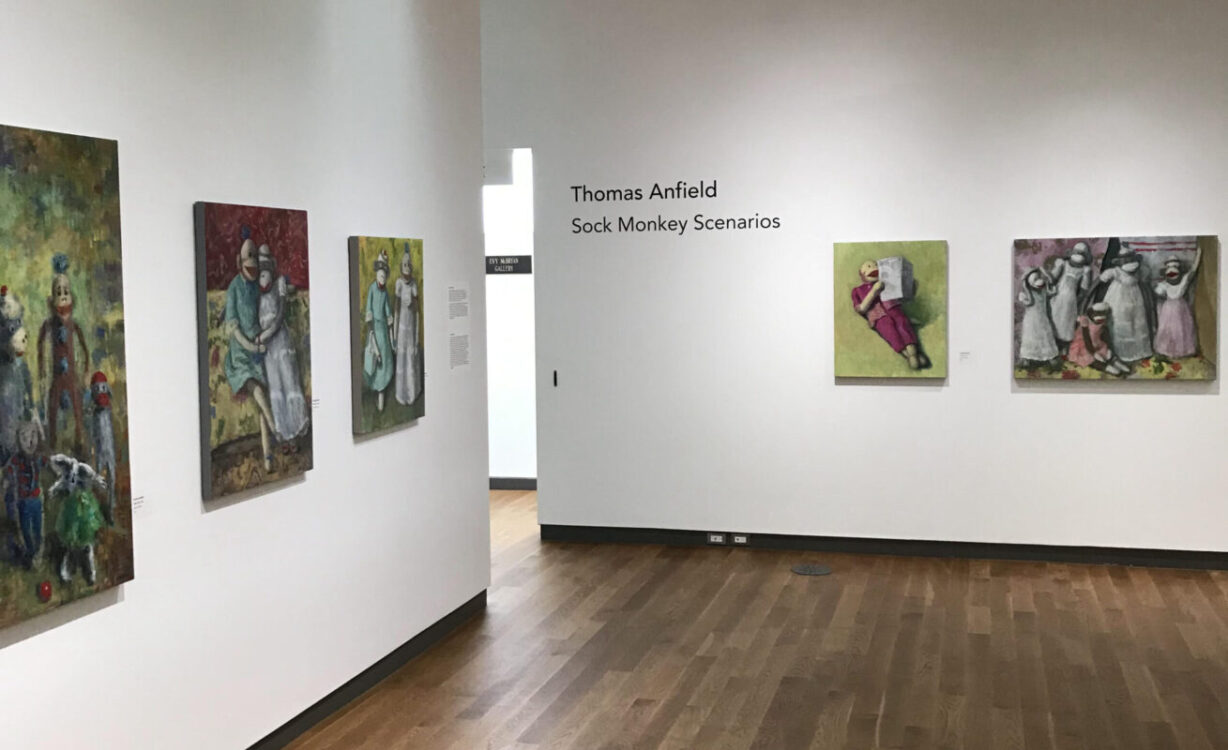Thomas Anfield Interview on the Sock Monkey Series
Freshly completing his solo exhibition at the Art Gallery of Grande Prairie, “Sock Monkey Scenarios”, Thomas Anfield’s monkeys return to Vancouver.
Curator of his recent exhibition, Sabine Schneider, described Anfield’s work as “shining a light on the complexity of being human and the constant shape-shifting we experience in the Theatre of Life.”
In our Thomas Anfield interview, we delve into neuroscience inspirations, symbolism, and gestural influences in Anfield’s Sock Monkey series, as it ties in with the closing of his successful solo show.
 What decisions drove you to select the Sock Monkeys as a stand-in for the human figure?
What decisions drove you to select the Sock Monkeys as a stand-in for the human figure?
I had been working for many years with a large stuffed dummy with its ability to be the site of our projections. Like the white painted body of the Butoh dancer, the blankness enables the viewers to self-identify and transfer their emotions, engaging the mirror neurons.
Mirror neurons are a type of brain cell that respond equally when we perform an action and when we witness someone else perform the same action. Discovered by Neuroscientist Giacomo Rizzolatti, MD and his team at the University of Parma, the neurons could help explain how and why we “read” other people’s minds and feel empathy for them.
The Monkeys started as small works (in Christmas shows) in which I quickly observed people related too, and often interpreted very similarly to my intentions. My work is highly influenced by neuroscientist V.S. Ramachandran and his ideas of how we read images and how the neural pathways are engaged. This includes the idea of how quickly the brain fires on symbolic form and images as opposed to more brain activation like recognizing individual faces. The happy face being a prime example. The monkeys being both symbolic and pre human are extremely potent symbols.
Thomas listens to lectures on the subject when he paints. He recommends “40/40 Vision Lecture: Neurology and the Passion for Art”

Would you describe the series as a method of self-reflection, or an outward observation of humanity?
While I don’t see myself as different than the “crowd”, the works are mostly observed social activity. Maybe I do see myself as slightly “outside” looking in. I see them as theatre. However, Sabine Schneider did point out that the latest Chubby monkey paintings are self portraits and I had to agree.
The monkeys have appeared in conjunction with other toys, in such works as “The Tree”. How do you curate what iconic toys of your childhood make it into your works?
The paintings are not nostalgic nor particularly rooted in childhood, or I have never left childhood to see them in contrast to an “adult” experience, I see them again as theatre as “puppets” or actors. Perhaps I have always been involved with collectors and dealers and have more experience in adulthood with toys and antiques than I did then, although plenty of toys were about. My daughter now has a huge collection of antique toys.

The Tree, Acrylic on canvas, 48 x 48 inches, $7,000
In our early developmental years, toys often become a stand-in for our loved ones and ourselves, as we explore the dynamics of social situations. Now, the toys are modeling behaviour though the lens of adulthood. How does placing your monkeys in adult social situations, like “Monkeys Drinking”, change the original connotation many viewers have with the beloved Sock Monkeys?
[Giving pause to reflect]… I don’t know how it may affect others. For me most “adult” social behaviour is an attempt at holding onto something that was so free and easy when they were younger. Being an artist for me is part of that idea. I’ll get old after I die, thanks.
 Working as a contemporary figure painter with a background in professional performance art, how does your mastery of movement, honed through Butoh dance, inform your figurative painting?
Working as a contemporary figure painter with a background in professional performance art, how does your mastery of movement, honed through Butoh dance, inform your figurative painting?
Mastery is a bit much but “engagement” with movement and the idea of bodies in space, of gesture and deportment has been fundamental to me. Butoh is very much about internal imagery, so this idea of getting inside the characters as I paint them is really important. Again, it’s theatre.
Here’s an interview I did that gets to the point made during my second monkey show at the Petley Jones Gallery on the Fanny Kiefer Show, Studio Four, Shaw TV, Vancouver:


You must be logged in to post a comment.